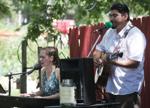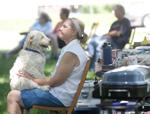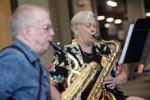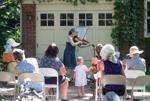Watch now: With techy cylindrical sculptures, Stoughton’s Zovar Fine Art weathers economic hurdles | Business News
7 min read [ad_1]
Inside his recently opened Stoughton art studio and shop, Ray Zovar takes a large piece of fabric that he painted with abstract, geometrical patterns and wraps it around a seven-foot white tube that he says was formerly a pig roaster.
Ray explains the process of making one of his specialty art pieces — cylindrical structures, whose designs come alive with interior LED lights that change color, that are displayed throughout Zovar Fine Art on Main Street along with Zovar’s other mixed media works that he sells. Other pieces that adorn the walls of his business, which opened around Black Friday last year, include mosaics and two-dimensional acrylic paintings.

Ray Zovar works in his studio at Zovar Fine Art in Stoughton.
“Once the fiber glass is on this (tube) and the painting is complete, then I take the painting and wrap that with resin,” Zovar said of what he’s coined as his illuminated sculptural paintings. “What (the pig roaster) will do is turn very slowly, and I’ll pour the resin over it in position. You can see what this is going to, more or less, look like at this stage of the game.”
“I saw some Chinese artists in a travelling show about 30 years ago,” he added of what inspires the fixtures, which Zovar started constructing almost a decade ago. “(During the show) a 360-degree painting was held up with four bamboo posts. All four sides were flat and I just kept it at the back of my mind.”

Illuminated sculpture works by artist Ray Zovar are displayed in the window of Zovar Fine Art in Stoughton.
Despite those three decades of artistry, a growing following online and the fact that his fixtures have decorated museums and even Dane County’s largest employer, healthcare software giant Epic Systems, Zovar as a small business owner has not been immune to some of the harsh realities the COVID-19 pandemic and a tumultuous economy have brought, especially for artists.
Inflation has caused the prices of goods like ink and rents for brick-and-mortar space to rise. In turn, artists who sell their pieces are forced to raise their prices, said owner of Williamson Street’s Hatch Art House Tammy Schreiter, who opened her business in 2010. Hatch Art House sells the work of 70 Wisconsin artists, all of whom create using various mediums.

Lisa Zovar arranges a display of Illuminated sculpture works created by her husband, Ray Zovar, at Zovar Fine Art in Stoughton.
“That falls to the consumer,” Schreiter said. “The artist always has to make sure they are getting paid properly.”
According to a 2021 U.S. Chamber of Commerce survey, nearly three in five small businesses nationally (67%) saw inflation price spikes drive up the cost of their products or services. Around half (45%) of survey respondents took out a loan to cover inflation losses, while 41% decreased staff.

Prints of mosaic works by Ray Zovar are displayed near recent awards earned by the artist at Zovar Fine Art in Stoughton.
For Zovar, business at his studio has been steady after a slow start last fall. Customers have flocked to the shop from across the Midwest, he said, adding that the studio’s target market is people with disposable incomes. The sale of one of his larger illuminated sculptures is enough to cover his monthly rent, he said, adding that the fixtures retail for thousands of dollars. Raising prices has not yet been a consideration.
That’s been a welcome relief as Zovar, who has exhibited his art at shows across the U.S. for years, has seen only light foot traffic at events. Due to the four to six hours it can take to install his pieces at exhibitions, Zovar has reduced the distance he travels, too. The farthest he’s gone is Florida.

A mosaic table created by Ray Zovar is displayed on the floor of his studio in Stoughton.
But if it weren’t for a $10,000 Main Street Bounceback grant out of the Wisconsin Economic Development Corp., said wife Lisa Zovar, renting the brick-and-mortar space last fall would not have been possible. Lisa calls herself the “artist left brain” of the duo, managing the shop’s finances, website and social media presence. Lisa and Ray are the shop’s only employees.
The couple knew they wanted a studio before applying for the WEDC money — and the state to fill the vacant storefronts of Dane County’s suburbs. Thanks in part to that effort, and some local events the Zovar’s are helping to spearhead, Lisa said Stoughton is becoming an “art enclave” as she pointed to shops that had recently opened across the street.

The tools of Ray Zovar’s art trade share a wall inside the workshop of his studio in Stoughton.
A Downtown art walk to get even more shoppers in the door is in the works for late September, Lisa said.
Ray and Lisa, who have lived in the Town of Dunn for 30 years, still worry that a recession may be on the horizon. Rising COVID case numbers are another concern, Lisa said.
Striking a ‘balance’
The life of an artist is about continuous problem-solving and adapting, said Schreiter, who launched Hatch Art House on “a shoestring budget” amid the Great Recession, and has weathered COVID.

Zovar Fine Art along East Main Street in Stoughton.
“Stay positive and make that little checklist,” she said when asked about what advice she had for new artists who wish to open their own brick and mortar space in the current financial climate. “Get your business plan ready.”
For creators without years of expertise and a large following, Schreiter said its a good idea to consider selling the pieces of several artists in addition to one’s own art.

Ray Zovar converses with visitors about his work in his studio in Stoughton.
Market research is also a must, she said, adding that she curates her product offerings specifically for her East Side neighborhood.
“The world we live in is a rollercoaster,” Schreiter said. “If you feel like its the right time (to open a brick and mortar space), know there’s always going to be something. We never saw a pandemic coming. I feel like it just boils down to you have to take your time and use it to your advantage.”

Ray Zovar spritzes colored dye onto the surface of a work in progress at this studio in Stoughton.
Having his reputation and audience as a backbone, Zovar was able to successfully adapt to the wave of show cancellations at the beginning of the pandemic.
Zovar, who began his career in Milwaukee right out of high school with an apprenticeship, saw that period as “restful” — a time to concentrate on his prose and business plans.
That’s what his vibrant sculptures represent: finding “balance,” even in chaos, he said.
Photos: Make Music Madison

Members of MAUI, Madison Area Ukulele Initiative, including Sue Carnell, center, and Pat Sheahan perform on the back patio at Chocolate Shoppe Ice Cream Company on Atwood Avenue during Make Music Madison in Madison, Wis., Tuesday, June 21, 2022.

Jennifer Andrea and Chente Medina, right, with Driving Buddies, perform on the back patio of Chocolate Shoppe Ice Cream Company on Atwood Avenue during Make Music Madison in Madison, Wis., Tuesday, June 21, 2022.

The group Molly Nova, including Molly Waugh, left, and her dad, Steve, at right, with Berlinda Lopez, center, perform at Wirth Court Park during Make Music Madison in Madison, Wis., Tuesday, June 21, 2022.

Megan Williamson, with her 5-year-old poodle-mix, Elliot, watches a band perform during Make Music Madison at Wirth Court Park in Madison, Wis., Tuesday, June 21, 2022. Williamson set up a table with free food and drinks for the performances at the park. AMBER ARNOLD, STATE JOURNAL

The group Third Lake Saxophones, including, Martha Florey and Tom Blankenheim, left, perform in a room at Madison Public Library’s Sequoya Branch during Make Music Madison in Madison, Wis., Tuesday, June 21, 2022.

Kylie Harrold and her 11-month-old son, Milo Moulton, listen to the group Molly Nova perform at Wirth Court Park during Make Music Madison in Madison, Wis., Tuesday, June 21, 2022.

Kate Carrigan Blackwell plays the viola for a crowd at a home in the Vilas neighborhood listed as “Bonnie’s Driveway” during Make Music Madison in Madison, Wis., Tuesday, June 21, 2022.

The group Third Lake Saxophones, including, from left, Tom Swoboda, Martha Florey, Tom Blankenheim and Gary Lensmeyer perform in a room at Madison Public Library’s Sequoya Branch during Make Music Madison in Madison, Wis., Tuesday, June 21, 2022.

The group Wild Violets, including Raquel Aleman, right, Sam Rae, front, and Becky Burbach perform outside the Barrymore Theatre during Make Music Madison in Madison, Wis., Tuesday, June 21, 2022.
[ad_2]
Source link






